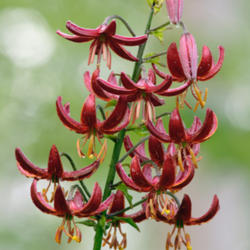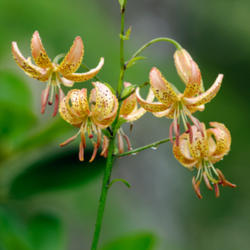I thought I'd revisit this thread with some new thoughts and results.
In the best performing garden with cold, open shade and some morning and very late afternoon sun 'Claude Shride' and 'Maroon King' both gave 2 blooming stems. 'Manitoba Morning' gave 4!!! Foliage has been looking good the whole time as well. These were bulbs I bought from Guntis Grants. They were enormous with beautiful healthy roots. Others of his gave one nice stem. The bulbs I bought from HW Hyde did the next best. These were good sized with for the most part a reasonable root system. All bloomed, but the foliage looks a bit unhappier. Sold as 12+, none were as small as that.
What was interesting was the cheap Claude Shride bulbs. Sold as size 22+, some were larger than that and they were dehydrated, but otherwise OK, but no roots. I planted 2 in the mentioned garden and both bloomed with a good stem. However the remaining 8 was planted in a bed that is a bit warmer, particularly in the afternoon and a bit drier. Of these only 2 managed two bloom and the rest aborted prior to bloom. This is only 25% success rate. Obviously they couldn't absorb as much water as they needed in these conditions.
I also planted 5 'Terrace City' in the first garden with cold open shade and they bloomed 100% with a smaller stem although the quality of the bulb was worse than the cheap 'Claude Shride'. They were much drier and a bit smaller bulbs. Sold as size 16/18.
In the third garden I planted 'Pepper Gold' or 'Peppard Gold' as it also is called and these were the absolutely worst bulbs. Lots of damages scales, a little rot and very, very dry. So had to remove some scales from them, but still one of them managed to bloom! One didn't emerge at all and was the only no show of all bulbs planted. Regarding suitability this third garden was a bit middle ground. Sunnier than the best garden, but not as warm as the worst.
So although one often says that martagons can take a bit of sun in a northern climate, one perhaps should take into account that particularly bulbs of poorer quality can suffer greatly in the first year if planted in a warmer site, even when adequately watered. But even bulbs of lesser quality can make a good first year in a really good site. We were for our conditions here in the southern part of Sweden extremely warm and sunny in May and a good portion of June. So colder weather could have given better results. One also have to take into account that I didn't plant any of the best bulbs in the warmer beds and that I compare different cultivars against each other, which isn't completely fair.
I didn't take any documentary photos of the bulbs but I have at least some images of how the bulbs of lesser quality bloomed:
22+ size dehydrated 'Claude Shride' , 100% (2 of 2 bulbs) bloomed in shade, 25% (2 of 8) in more sun.
Size 16/18, "Can't-believe-I'm-still-alive-quality", 'Peppard Gold' 20% (1 of 5) bloomed



